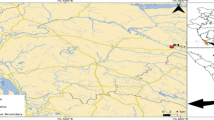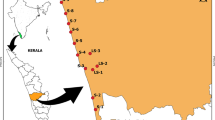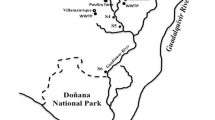Abstract
The presence of emerging contaminants (ECs) in different aquatic systems may contribute to hazardous effects on aquatic organisms and subsequently on human health. In the present work, liquid chromatography coupled to a quadrupole time of flight mass spectrometer (LC-Q-ToF-MS) was used to identify and quantify a series of ECs in Periyar River in Aluva region, Kerala, India. The water samples were pre concentrated using solid-phase extraction (SPE) prior to analysis. The compounds were probed in both positive and negative ionization mode using electro spray ionization (ESI). Method validations were performed for linearity, limit of detection (LOD), limit of quantification (LOQ), accuracy, and precision (intraday and inter day). The ECs were quantified using standard calibration curve. The identified nine ECs include pharmaceuticals, personal care products, steroids, surfactants, and phthalate. A relatively high concentration was observed in the case of 2-dodecyl benzene sulfonic acid (1012 ng/l) and low concentration was observed for lignocaine (4.3 ng/l; since this is below LOQ, the value is only approximate). In addition, we have identified another 28 organic compounds using the technique of non-target analysis out of which seven compounds fall in the category of surfactants. Being the first report on ECs in Periyar River, the data is very important as this river is one of the biggest and important rivers of Kerala having several purification units for drinking water in the province.



Similar content being viewed by others
References
Abramović, B. F., Banić, N. D., & Šojić, D. V. (2010). Degradation of thiacloprid in aqueous solution by UV and UV/H2O2 treatments. Chemosphere, 81, 114–119.
Al-Odaini, N. A., et al. (2010). Multi-residue analytical method for human pharmaceuticals and synthetic hormones in river water and sewage effluents by solid-phase extraction and liquid chromatography–tandem mass spectrometry. Journal of Chromatography A., 1217, 6791–6806.
Andrási, N., Molnár, B., Dobos, B., Vasanits-Zsigrai, A., Záray, G., & Molnár-Perl, I. (2013). Determination of steroids in the dissolved and in the suspended phases of wastewater and Danube River samples by gas chromatography, tandem mass spectrometry. Talanta, 115, 367–373.
Birkholz, D. A., et al., 2.11—Analysis of emerging contaminants in drinking water—a review A2—Ahuja, Satinder. Comprehensive water quality and purification. Elsevier, Waltham, 2014, pp. 212–229.
Bueno, M. J. M., Agüera, A., Hernando, M. D., Gómez, M. J., & Fernández-Alba, A. R. (2009). Evaluation of various liquid chromatography-quadrupole-linear ion trap-mass spectrometry operation modes applied to the analysis of organic pollutants in wastewaters. Journal of Chromatography A., 1216, 5995–6002.
Camacho-Muñoz, D., Martín, J., Santos, J. L., Aparicio, I., Alonso, E. (2014). Occurrence of surfactants in wastewater: Hourly and seasonal variations in urban and industrial wastewaters from Seville (Southern Spain). Science of The Total Environment, 468-469, 977-984.
Central Pollution Control Board (1993). http://www.hppcb.gov.in/eiasorang/spec.pdf. Accessed 3 April 2013.
Chiesa, L. M., Nobile, M., Biolatti, B., Pavlovic, R., Panseri, S., Cannizzo, F. T., & Arioli, F. (2016). Detection of selected corticosteroids and anabolic steroids in calf milk replacers by liquid chromatography–electrospray ionisation—tandem mass spectrometry. Food Control, 61, 196–203.
Clara, M., Strenn, B., & Kreuzinger, N. (2004). Carbamazepine as a possible anthropogenic marker in the aquatic environment: investigations on the behaviour of carbamazepine in wastewater treatment and during groundwater infiltration. Water Research, 38, 947–954.
Dell’Arciprete, M. L., Cobos, C. J., Furlong, J. P., Mártire, D. O., & Gonzalez, M. C. (2007). Reactions of sulphate radicals with substituted pyridines: a structure–reactivity correlation analysis. Chemphyschem, 8, 2498–2505.
Dirtu, A., et al. (2012). Analytical methods for selected emerging contaminants in human matrices—a review. Analytical and Bioanalytical Chemistry., 404, 2555–2581.
Gao, D.-W., Li, Z., Guan, J. X., & Liang, H. (2017). Seasonal changes and spatial distributions of nonylphenol ethoxylates in sewage treatment plant with BAF process. Environmental Technology., 38, 406–412.
Gómez, M. J., Gómez-Ramos, M. M., Malato, O., Mezcua, M., & Férnandez-Alba, A. R. (2010). Rapid automated screening, identification and quantification of organic micro-contaminants and their main transformation products in wastewater and river waters using liquid chromatography–quadrupole-time-of-flight mass spectrometry with an accurate-mass database. Journal of Chromatography A., 1217, 7038–7054.
Haman, C., Dauchy, X., Rosin, C., & Munoz, J. F. (2015). Occurrence, fate and behavior of parabens in aquatic environments: a review. Water Research, 68, 1–11.
Han, C., Xia, B., Chen, X., Shen, J., Miao, Q., & Shen, Y. (2016). Determination of four paraben-type preservatives and three benzophenone-type ultraviolet light filters in seafoods by LC-QqLIT-MS/MS. Food Chemistry., 194, 1199–1207.
Hernández, F., Sancho, J. V., Ibáñez, M., Abad, E., Portolés, T., & Mattioli, L. (2012). Current use of high-resolution mass spectrometry in the environmental sciences. Analytical and Bioanalytical Chemistry., 403, 1251–1264.
Herrera Rivera, Z., Oosterink, E., Rietveld, L., Schoutsen, F., & Stolker, L. (2011). Influence of natural organic matter on the screening of pharmaceuticals in water by using liquid chromatography with full scan mass spectrometry. Analytica Chimica Acta, 700, 114–125.
Jeon, H.-K., Chung, Y., & Ryu, J. C. (2006). Simultaneous determination of benzophenone-type UV filters in water and soil by gas chromatography–mass spectrometry. Journal of Chromatography A., 1131, 192–202.
Kalsoom, U., et al. (2012). Degradation and kinetics of H2O2 assisted photochemical oxidation of Remazol Turquoise Blue. Chemical Engineering Journal., 200–202, 373–379.
Kelly, C. (2000). Analysis of steroids in environmental water samples using solid-phase extraction and ion-trap gas chromatography–mass spectrometry and gas chromatography–tandem mass spectrometry. Journal of Chromatography A., 872, 309–314.
Kolpin, D. W., Furlong, E. T., Meyer, M. T., Thurman, E. M., Zaugg, S. D., Barber, L. B., & Buxton, H. T. (2002). Pharmaceuticals, hormones, and other organic wastewater contaminants in US streams, 1999−2000: a national reconnaissance. Environmental Science & Technology., 36, 1202–1211.
Kosma, C. I., et al. (2014). Investigation of PPCPs in wastewater treatment plants in Greece: occurrence, removal and environmental risk assessment. Science of The Total Environment., 466–467, 421–438.
Larsen, T. A., Lienert, J., Joss, A., & Siegrist, H. (2004). How to avoid pharmaceuticals in the aquatic environment. Journal of Biotechnology., 113, 295–304.
Li, W. C. (2014). Occurrence, sources, and fate of pharmaceuticals in aquatic environment and soil. Environmental Pollution., 187, 193–201.
Lima Gomes, P. C. F., Barnes, B. B., Santos-Neto, Á. J., Lancas, F. M., & Snow, N. H. (2013). Determination of steroids, caffeine and methylparaben in water using solid phase microextraction-comprehensive two dimensional gas chromatography–time of flight mass spectrometry. Journal of Chromatography A., 1299, 126–130.
Lin, Y., et al., (2016) Simultaneous qualitative and quantitative analysis of fluoroalkyl sulfonates in riverine water by liquid chromatography coupled with Orbitrap high resolution mass spectrometry. Journal of Chromatography A.
Liu, S., Ying, G. G., Zhao, J. L., Chen, F., Yang, B., Zhou, L. J., & Lai, H. J. (2011). Trace analysis of 28 steroids in surface water, wastewater and sludge samples by rapid resolution liquid chromatography–electrospray ionization tandem mass spectrometry. Journal of Chromatography A., 1218, 1367–1378.
López-Serna, R., Petrović, M., & Barceló, D. (2012). Direct analysis of pharmaceuticals, their metabolites and transformation products in environmental waters using on-line TurboFlow™ chromatography–liquid chromatography–tandem mass spectrometry. Journal of Chromatography A., 1252, 115–129.
Martinez, J. L. (2009). The role of natural environments in the evolution of resistance traits in pathogenic bacteria. Proceedings of the Royal Society of London B: Biological Sciences., 276, 2521–2530.
Maruthamuthu, P., & Neta, P. (1977). Reactions of phosphate radicals with organic compounds. The Journal of Physical Chemistry., 81, 1622–1625.
Moraes, F. C., Rossi, B., Donatoni, M. C., de Oliveira, K. T., & Pereira, E. C. (2015). Sensitive determination of 17β-estradiol in river water using a graphene based electrochemical sensor. Analytica Chimica Acta, 881, 37–43.
Nejumal, K. K., et al. (2017). Presence of bisphenol S and surfactants in the sediments of Kongsfjorden: a negative impact of human activities in Arctic? Environmental Monitoring and Assessment., 190, 22.
Ngumba, E., Gachanja, A., & Tuhkanen, T. (2016). Occurrence of selected antibiotics and antiretroviral drugs in Nairobi River Basin, Kenya. Science of The Total Environment., 539, 206–213.
Oliveira, T. S., et al. (2015). Characterization of pharmaceuticals and personal care products in hospital effluent and waste water influent/effluent by direct-injection LC-MS-MS. Science of The Total Environment., 518–519, 459–478.
Olkowska, E., Polkowska, Ż., & Namieśnik, J. (2012). Analytical procedures for the determination of surfactants in environmental samples. Talanta, 88, 1–13.
Ouyang, X., Leonards, P., Legler, J., van der Oost, R., de Boer, J., & Lamoree, M. (2015). Comprehensive two-dimensional liquid chromatography coupled to high resolution time of flight mass spectrometry for chemical characterization of sewage treatment plant effluents. Journal of Chromatography A., 1380, 139–145.
Pignatello, J. J., Oliveros, E., & MacKay, A. (2006). Advanced oxidation processes for organic contaminant destruction based on the Fenton reaction and related chemistry. Critical Reviews in Environmental Science and Technology., 36, 1–84.
Portolés, T., Mol, J. G. J., Sancho, J. V., & Hernández, F. (2014). Use of electron ionization and atmospheric pressure chemical ionization in gas chromatography coupled to time-of-flight mass spectrometry for screening and identification of organic pollutants in waters. Journal of Chromatography A., 1339, 145–153.
Prebihalo, S., Brockman, A., Cochran, J., & Dorman, F. L. (2015). Determination of emerging contaminants in wastewater utilizing comprehensive two-dimensional gas-chromatography coupled with time-of-flight mass spectrometry. Journal of Chromatography A., 1419, 109–115.
Rauf, M. A., & Ashraf, S. S. (2009). Fundamental principles and application of heterogeneous photocatalytic degradation of dyes in solution. Chemical Engineering Journal., 151, 10–18.
Rayaroth, M. P., et al. (2015). Identification of chlorophene in a backwater stream in Kerala (India) and its sonochemical degradation studies. CLEAN – Soil, Air, Water., 43, 1338–1343.
Robles-Molina, J., Gilbert-López, B., García-Reyes, J. F., & Molina-Díaz, A. (2013). Gas chromatography triple quadrupole mass spectrometry method for monitoring multiclass organic pollutants in Spanish sewage treatment plants effluents. Talanta, 111, 196–205.
Robles-Molina, J., et al. (2014). Monitoring of selected priority and emerging contaminants in the Guadalquivir River and other related surface waters in the province of Jaén, South East Spain. Science of The Total Environment., 479–480, 247–257.
Rua-Gomez, P. C., & Puttmann, W. (2012). Impact of wastewater treatment plant discharge of lidocaine, tramadol, venlafaxine and their metabolites on the quality of surface waters and groundwater. Journal of Environmental Monitoring., 14, 1391–1399.
Salvador, A., & Chisvert, A. (2005). Sunscreen analysis: a critical survey on UV filters determination. Analytica Chimica Acta, 537, 1–14.
Selvarajan, N., & Raghavan, N. V. (1980). Reaction of hydroxyl with pyridine. Pulse-radiolytic and product-analysis studies. The Journal of Physical Chemistry., 84, 2548–2551.
Stapleton, D. R., Konstantinou, I. K., Karakitsou, A., Hela, D. G., & Papadaki, M. (2009). 2-Hydroxypyridine photolytic degradation by 254 nm UV irradiation at different conditions. Chemosphere, 77, 1099–1105.
Stoob, K., Singer, H. P., Goetz, C. W., Ruff, M., & Mueller, S. R. (2005). Fully automated online solid phase extraction coupled directly to liquid chromatography–tandem mass spectrometry: quantification of sulfonamide antibiotics, neutral and acidic pesticides at low concentrations in surface waters. Journal of Chromatography A., 1097, 138–147.
Acknowledgements
KKN and CTA are thankful to the KSCSTE, Thiruvananthapuram for a research fellowship, and for financial support, respectively
Author information
Authors and Affiliations
Corresponding author
Electronic supplementary material
ESM 1
(DOC 234 kb)
Rights and permissions
About this article
Cite this article
Khalid, N.K., Devadasan, D., Aravind, U.K. et al. Screening and quantification of emerging contaminants in Periyar River, Kerala (India) by using high-resolution mass spectrometry (LC-Q-ToF-MS). Environ Monit Assess 190, 370 (2018). https://doi.org/10.1007/s10661-018-6745-9
Received:
Accepted:
Published:
DOI: https://doi.org/10.1007/s10661-018-6745-9




